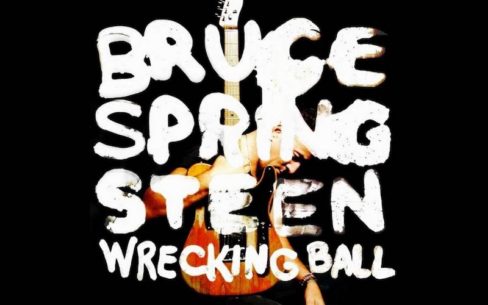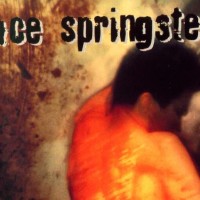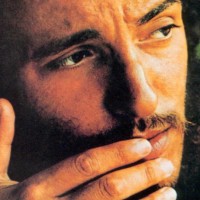
Bruce Springsteen returned March 6, 2012 with a challenging album that reflected the injustices intrinsic to our recent history.
Thematically, Wrecking Ball was split into two parts. The first half — from Springsteen’s defiant advance single “We Take Care of Our Own” through desolate “This Depression,” gave a soapbox to the down and out, the people dealing with the aftermath of economic and social breakdown. The title track then kicked off part two, which allowed a little hope into the discussion.
Springsteen employed elements both old (protest folk, gospel, an incendiary horn section) and new (electronic beats, samples). There were masterful uses of irony (the cornpone, cartoonish characters of “Easy Money,” thinking crime-laden thoughts but set to such cheerful music), dynamic explosions of emotion (Tom Morello’s “Jack of All Trades” guitar solo), and gospel tinges as well (the sample of the Alan Lomax-recorded Alabama Sacred Heart Singers that is the underlayment of the stomping “Death to My Hometown,” the entirety of “Rocky Ground.”) Kudos to Bruce Springsteen (and producer Ron Aniello) for thinking far outside the E Street box.
As the hope of side two continued to build, we got to the emotional final roar of Clarence Clemons, who brought it during a remake of “Land of Hope and Dreams.” Even though I knew this was coming, it was still a moment that was difficult to take. Clarence, indeed, lives on. “We Are Alive” then ran with that idea of the influential spirit, bringing home the transformative power of love with a clever quote from Johnny’s Cash’s “Ring of Fire.”
Here’s a look back at five spiritual, defiant, soaring moments from Bruce Springsteen’s Wrecking Ball.
“WE TAKE CARE OF OUR OWN”
Shortly after the announcement of this advance single, I had to start making plans for my midnight purchase. The time came and I downloaded the new single, going through Amazon’s silly 8- or 12-click process … and then enduring a launch of Windows Media Player (which I did not ask for), which in turn popped up a request for a software update. C’mon guys, I just want to listen to some new Bruce! So I transferred the mp3 file to my Android phone and then went off to bed.
I popped in the earbuds, pulled the comforter up over my head, and pressed play. Nobody could see it, but a huge grin came across my face. The drums lead into the Telecaster arpeggios, and then the glockenspiel, and piano, and …
… and I’m a kid again. This is where I almost feel sorry for the nitpickers. It’s like people forget what the joy of discovery is like, choosing to remain attached to a kind of negative spirit that suits every occasion. Is it a control thing? I guess I don’t know, and certainly won’t spend a whole lot of time trying to figure it out.
So press play I did. About 10 times. Not long after this — and realizing that I was cranked full of adrenaline — I spent a little time poking about on the Internet. I saw a tweet from this writer (and fellow Bruce Springsteen fanatic) who I follow. She had already posted her initial thoughts on “We Take Care of Our Own.” It was heartening to read that there’s somebody else out there able to get in touch with, as she put it, her “giddy 16-year-old” self.
Life’s too short to be spending so much of it looking for flaws in everything. It’s a big ole world out there. You keep that up, and you’re going to miss a whole lot.
Much had already been said (mostly in an insanely speculative and/or dismissive manner) about Springsteen and the anger that Wrecking Ball would be infused with. Yes, Mr. Springsteen is a rich man, so of course he can have nothing to be angry about. Really? Take a look at this sad and inspiring video, put together by Bruce fan extraordinaire Gina Giambone.
Thanks, Bruce. Thanks, Anne. Thanks, Gina.
“SHACKLED AND DRAWN”
While the references to the have and the have-nots on Wrecking Ball had so far been fairly elliptical (especially on “We Take Care of Our Own”), this song drew up a much starker contrast with a man “trudging through the dark in a world gone wrong” and, more pointedly: “up on banker’s hill the party’s going strong / down here below we’re shackled and drawn.”
The music again employed a light-against-dark vision, with the story of the oppressed framed by an insistent beat, guitars, and a sing-song melody running through the ecstatic chorus. As the track ended, the music dissolved to the voice of a female preacher, closing it all out with “I want everybody to stand up and be counted tonight!”
Powerful stuff.
“DEATH TO MY HOMETOWN”
Imagine towns both small and large, all across a country. Their essence has been drained by “progress” and blind greed, the result being the disappearance of factories, home foreclosures, and all manner of economic chaos. Those in power do their best to look the other way. Worse than that, they try to convince everybody else that the blame should not be directed at the institutions who are so obviously at fault. It’s political sleight of hand.
But the people are not fooled. And their collective anger rises as they can see that their futures have been compromised, only to pad the futures of the others.
This is the stuff of all great protest songs. In the spirit of Woody Guthrie, but soaked in hopeful Celtic bravado, “Death to My Hometown” raved on at the needless (and heartless) destruction.
“LAND OF HOPE AND DREAMS”
First, I have to admit that I was never the biggest fan of this song. Or more accurately, I didn’t like it placed later in the live set. It seemed like the tempo dragged things down. There, I said it.
So then I found out that Bruce Springsteen made a new studio version for Wrecking Ball. Hmmmm … what did that mean? Well, it meant that Clarence Clemons got to have one last say, though obviously that wasn’t the angle at recording time.
Whatever the reason, “Land of Hope and Dreams” had undergone the WreckingBallTreatment™ – and, along the way, became one of my favorite songs on the album. The song now begins with preacherly invocations of “This train …” floating above a bed of church organ pedal tones, to which banjo arpeggios, a choir, and a few choice beats were added. And then: boom! In came some rumbling rhythm guitar leading to the mandolin that played out the hook. This new arrangement provided an exhilarating jolt of energy that made me think it would actually work as a show opener!
But it wasn’t the new beginning … and it wasn’t the nice quotes of Curtis Mayfield’s “People Get Ready” toward the end. No, none of the new touches could compete with Clemons’ last saxophone solo. I knew it was coming, but the first time I heard that horn roar to life, it brought a tear to my eye. Thanks again, Big Man.
“WE ARE ALIVE”
Much was said in response to the notion that Wrecking Ball was to be Bruce Springsteen’s “angriest” album. People seemed to have in their heads a firm notion of what it means to be angry. So when the music surfaced, opinions crystallized around that thread, commonly expressing bemusement at the seeming lack of anger. Were they expecting 45 minutes of “Adam Raised a Cain”?
To me the emotion seemed obvious, a rage against economic injustice. That that rage came from many angles — employing everything from direct stories of despair to ironic near-parodies of criminal intent — did not diffuse the message.
And yet, as the second half of the album gained momentum, it became obvious that Springsteen was intent on letting light rays of hope cut through the darkness. “We Are Alive” brought Wrecking Ball to an end with a reminder that ideas, grand statements, and movements can’t be killed even as our physical selves die:
It’s only our bodies that betray us in the end
The musical quoting of Johnny Cash’s “Ring of Fire” is no cheap trick here, as it was a song that illustrated how love’s power can guide a person, ultimately transforming them. In “We Are Alive,” we have the ghosts of people who stood up for what they felt was right, raising their hands in unison. They loved their fellow man and took a stand, paying the ultimate price. They may be gone but their spirit and their ideals will never die.
We are alive
And though our bodies lie alone here in the dark
Our spirits rise to carry the fire and light the spark
To stand shoulder-to-shoulder and heart-to-heart
- Why the Rolling Stones’ Harrowing ‘Gimme Shelter’ is Still Revealing New Depths - November 18, 2024
- How Talking Heads’ ‘Fear of Music’ Opened Up a World of Art and Sound - August 5, 2024
- How Deep Cuts Propelled Bruce Springsteen’s ‘Born in the U.S.A.’ - June 4, 2024



